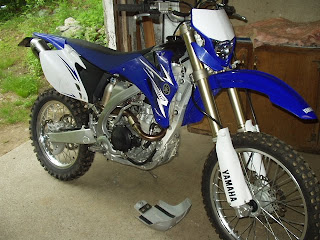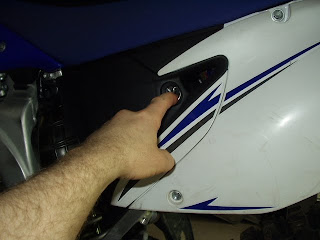
My WR-250FY.
The skid plate is removed because we're gonna' do some pre-ride wrenchin'. :)
I've got two Yamaha motorcycles that go by the designation WR-250.
For a lot of people, this is going deep enough as far as just what these two bikes are all about.
The truth is, they're as different as apples and oranges, basically.
The one I ride on the street is the WR-250R, a dual-purpose bike.
The one in this post is the WR-250F, also called by me as the Fire Breather.
What's that supposed to mean?
I've got a pretty far out and mischievous sense of humor, and that's just my way of explaining to somebody exactly what WR-250 I'm talking about.
The WR-250F is 40 lbs. lighter, makes 15% more power, and is a more high-performance motorcycle than the WR-250R in every way.
It should be, because it's based on the YZ-250F, the motocross bike.
No, this WR-250F ain't a clam, I'm happy to say.
Later today, I'm loading the bike up for another ride out in the Pachaug state forest, and like anybody else out there in Motoland, if you give half a shit about the bike you'll be riding, you'll be giving it a pre-ride inspection and some good ol' TLC.
TLC?
That an acronym (look it up):
T = Tender
L = Love
(and)
C = Care
Now you know. :)

Do you know what your carburetor drain screw is doing right now?
First of all, you should really, really have a Service Manual for your bike.
Yes, you should.
I've got one for mine, but since I have it memorized, I usually don't need it at arm's reach while working on my bike.
That's what eating right and getting plenty of sleep does for your brain.
I want to change the engine oil and oil filter this weekend, so I'll start that process by starting the engine and running it for a few minutes in order to warm the oil up as well as stir it up a bit.
If my bike has been sitting for more than one day, I'll drain the fuel out of the carburetor via this little, itty-bitty drain screw at the bottom of it.
Yes, Buckwheat, that's what it's there for.
Gasoline that you buy at the pump these days doesn't stay fresh all that long, and since the carburetor bowl where the gas is kept inside the carburetor is vented to the atmosphere by that gaggle of hoses attached to it, I'll drain away that week-old gasoline.
When that's done, opening the fuel petcock and allowing some fresher gas in from the fuel tank lets me start this bike with one kick.
Really.
Lefty-loosey.
I once knew a Lucy, and she was a lefty.
After the engine has been run for about 5 minutes, it's shut off and the real fun begins.
On the WR-250FY, the majority of the engine's oil is kept in this neat little aluminum tank just in front of the engine.
As you probably know from playing with your drinking straws while sitting at McDonalds and Burger King, your Coke won't flow out of the straw if you hold your finger over the top of it.
Same principle here, Lenny.
Removing this bolt and sealing washer lets the air in as the oil comes out the bottom.
Two drains for twice the pain.
No, I don't complain because my bike has two spots where the engine oil has to be drained from, but some guys out there in Motorcycle Forumland make it seem like some kind of giant pain in the ass.
Get the frig over it, would you?
They're only a few inches apart, for cripe's sake.
You make it sound like you've got to jump in your car and drive 50 miles to go reach the other one.
Jeeeeez.
Why two?
One for the oil tank, and one for the engine, itself.
Even though most of the oil is in the tank, some will be inside the engine, too.
Both of these drain bolts and sealing washers are removed so that old crude can be drained into my drain pan.
The writing's on the wall.
Down in this 45 year-old garage, where an army of kids grew up, there's a whole lot of scribbling on the walls from when their young minds were still developing and because they needed a place to hone their penmanship.
It was never painted over, so, maybe one day in a future post I'll showcase and explain these 35 year-old writings.
That'll bring back memories. :)
That'll bring back memories. :)
The WR-250FY holds one single quart of oil, so it doesn't take too long to drain off.
This means I don't have a lot of time to admire the greenery outside.
I like this time of year. :)
Neat little critter, huh?
I've heard of guys putting these in backwards, but since doing that requires practically hammering the cover back on, that's a mind-blower to me.
This shows how it goes back in on a WR-250FY.
Oil.
Not just for breakfast, anymore.
With the drain bolts and oil filter secure, some yummy, delicious Yamalube is poured into the engine.
How convenient that one quart of oil is the amount I'll need to do the job, eh?
Cuts down on the number of half-quarts cluttering up the place.
Shut your hole.
I will, just as soon as I pour that quart of oil through it.
OK?
Everyone likes stickers.
Do YOU know what these letters stand for?
Prove it. :)
It's hairy.
Hairy arms, that is.
Next on the agenda is servicing another filter.
Fact:
I'm amazed to this very day how many long-time riders I've known that don't seem to pay much attention to what's behind this side panel.
Do you know what it is?
It's that blue butt, again.
Yes, people, it's the air filter.
Very, very important stuff, this is.
Want to make your bike stop running and then have to spend big bucks making it right, again?
Neglect this little devil.
I remember reading in the Service Manual for my very first motorcycle about frequent air filter servicing.
I read how it should be done after each ride when riding off road.
At the time, I felt that whoever wrote that was smoking some heavy reefer, but now I know that it is very true.
It's high time (ha, ha - reefer. High. Geddit? :) ) that you all realize that, too.
If you already know this, bake yourself a cookie - a real big one with lots of big chocolate chips.
You deserve it for knowing what a lot of guys refuse to know.
Mmmmmmmm.
Chocolate chips.
Chocolate chips.
Much better here than inside your engine.
Look at that purdy Maxima FFT doing it's job.
It's enough to bring a tear to my eye.
Anyone got a hanky?
*blows nose*
Here's your hanky back. :)
What I'm using is a Maxima pre-oiled Pro filter.
For 99.9% of my motorcycling life, I've cleaned and re-oiled my air filters.
In fact, I still have the stock filter and a Twin Air filter on a shelf down here in the garage for this bike.
Lately, though, I've been using these filters from Maxima.
Why not?, I thought, since they're well-made, inexpensive (costs me about $6.50 each), and come perfectly oiled with my pick in filter oils.
You know what that is.
Don'cha'?
Don'cha'?
Sticker for me!
Sticker for me!
Hmmmmmm.
Now, where should I stick it?
Don't answer that. :)
Don't answer that. :)
Another control.
I need control.
We all need control.
The second and third lines are to a song that you should be delighted to look up.
Another important thing of mine is to lube the clutch cable and clutch cable adjuster, as well as the pivot of the clutch lever, itself.
It was none other than Bob Hannah, himself, who said in an interview with either Motocross Action or Dirt Bike magazine that he was constantly amazed with how many guys keep their controls in poor working order.
Things like torn grips, bent handlebars, and dry and squeaky and creaky clutch cables.
I don't go for any of that silly shit.
Uh-uh.
So, removing that cable from it's usual spot is in order.
See this cable?
It's saying, "Feed me."
Some guys (lots, actually) will insist that you shouldn't lube your cables because it attracts dirt.
I never agreed with that thinking.
My translation of that was always, "I just too lazy to do it."
Don't you try to fool me with your tomfoolery, Tom.
You got that?
You got that?
There's no way in hell you'll convince me that a freshly-lubed cable doesn't work better than your 6-month-old dry one.
Save it for some other guy.
The right tool for the job.
Are you a tool?
Then buy one of these.
Now.
This little device gets clamped over the end of the cable, making a nice and tight seal when you tighten down that thumb screw.
There's a little hole in it which is made to accept the straw from your can of cable lube (I always use Bel-Ray 6-in-1).
After jamming the straw in the hole, you squirt away, and the pressure from the can forces the lube down the cable.
Pretty neat, huh?
You bet your ass it is.
I just said ass.
I just said ass.
So what?
You have, too.
Yes, you have. :)
Greasy fingers smearing shabby clothes.
Those are words to yet another song.
It's up to you to find out which song.
An important part of this job is putting grease on the cable end.
Why?
Because of physics.
When you pull on your clutch lever, that end of the cable actually rotates inside of the clutch lever.
When your buddy breaks a clutch cable because he's far too much of a lazy slob to do this stuff to his bike, it almost always breaks up near the top end of the cable.
That's because his silly ass let things deteriorate to the point where the cable end froze in the clutch lever, and every time he pulled the lever, the cable wire, itself, was being forced to bend sharply.
Over and over and over again, until one day, the cable said, "Enough of this bullshit!"
Keeping this well-lubed prevents this from happening.
Now you know.
Can't stand the pressure?
Let it out.
All of it.
Last on the list today is relieving the forks of any air pressure that has built up inside of them.
There once was a time, waaaaaay back in the Stone Age, where forks actually used air pressure to help hold the bike up.
There once was a time, waaaaaay back in the Stone Age, where forks actually used air pressure to help hold the bike up.
Not any more.
In fact, with modern dirt bikes, anyway, today's logic says that you want zero air pressure inside of them.
Since just a change in air temperature can pressurize them, letting any air pressure out before the ride is a groovy thing to do.
Yeeeeaaaaahh.
Ready to romp.
That didn't take too long and it didn't kill me.
-John



















No comments:
Post a Comment